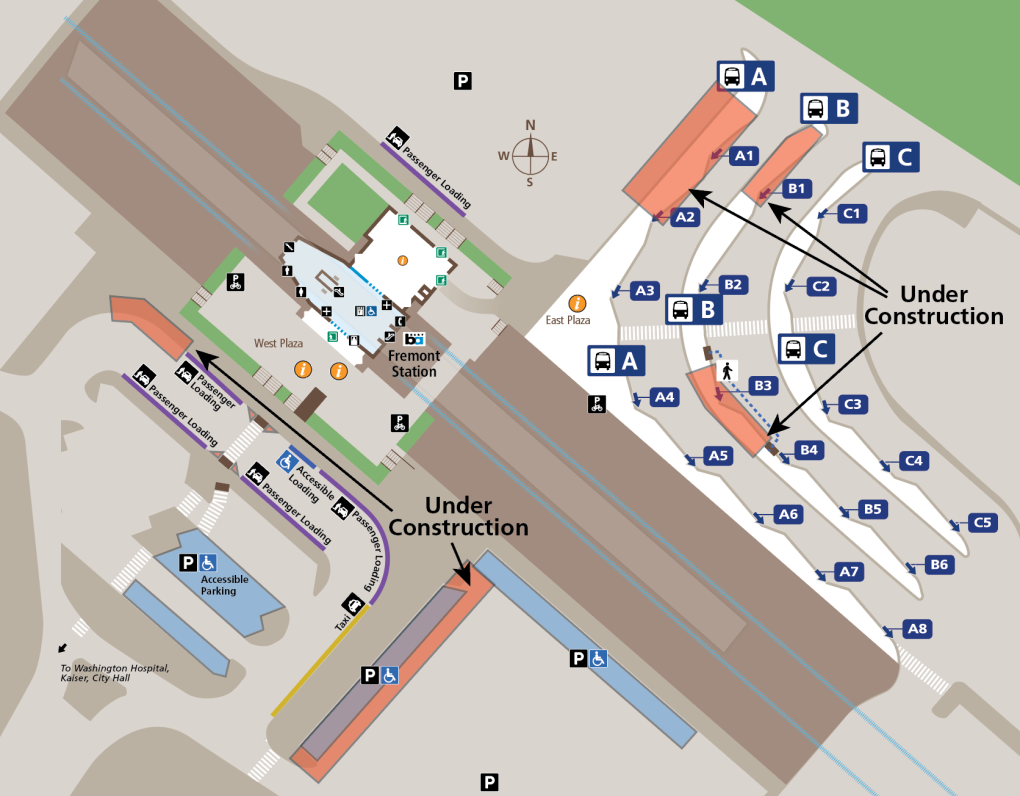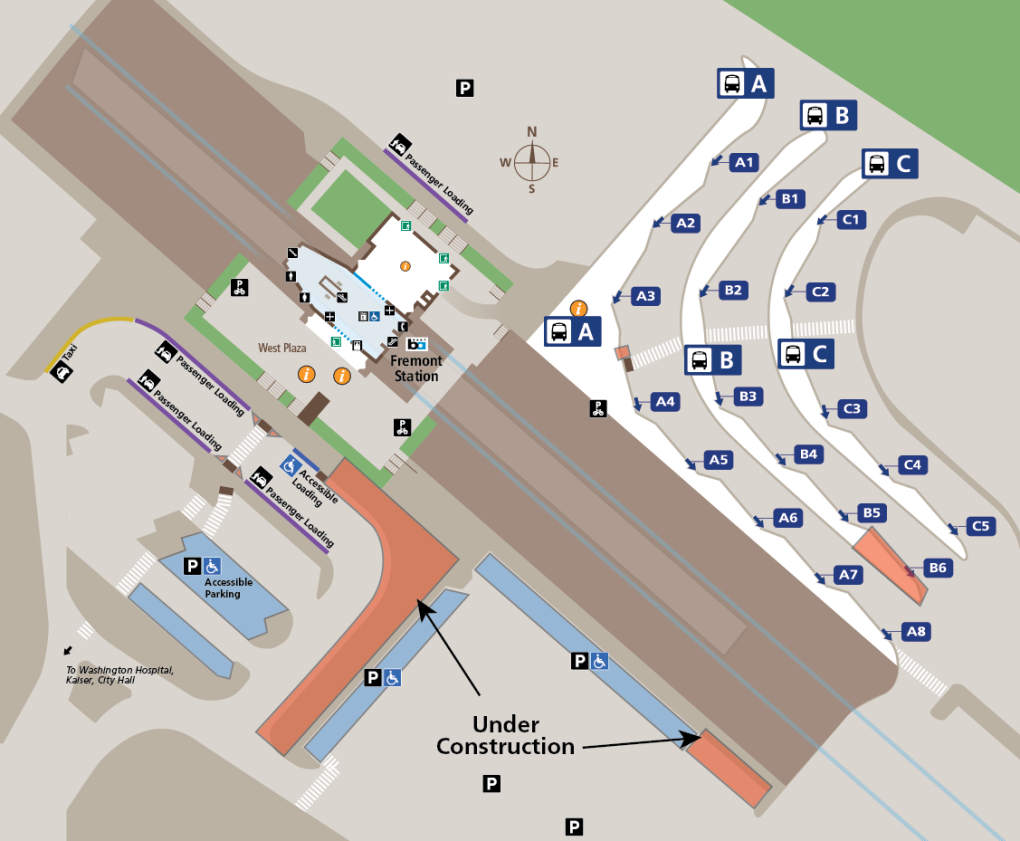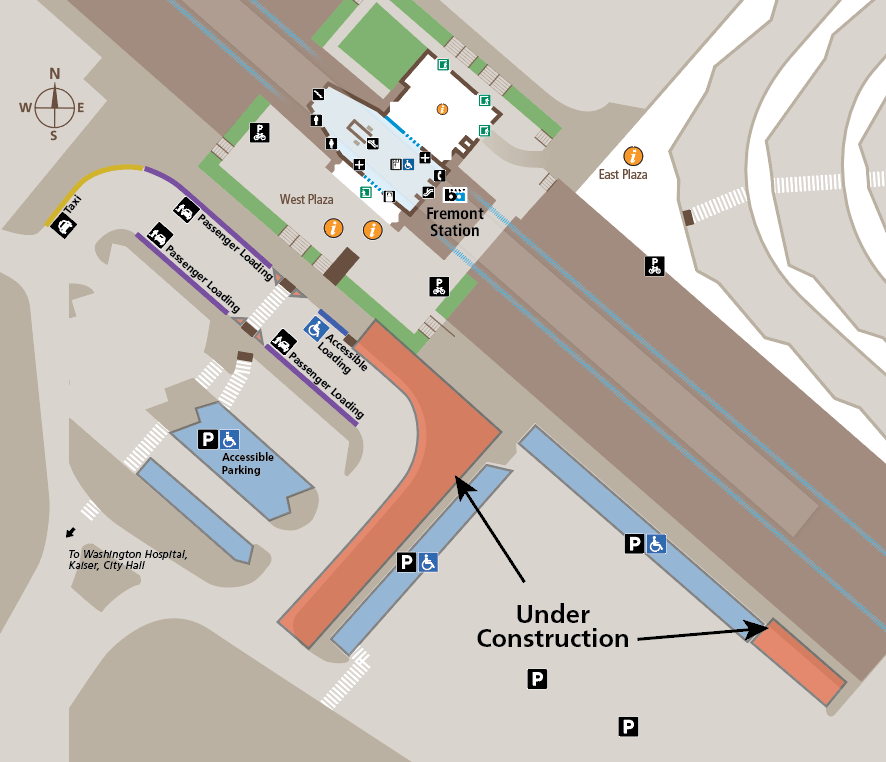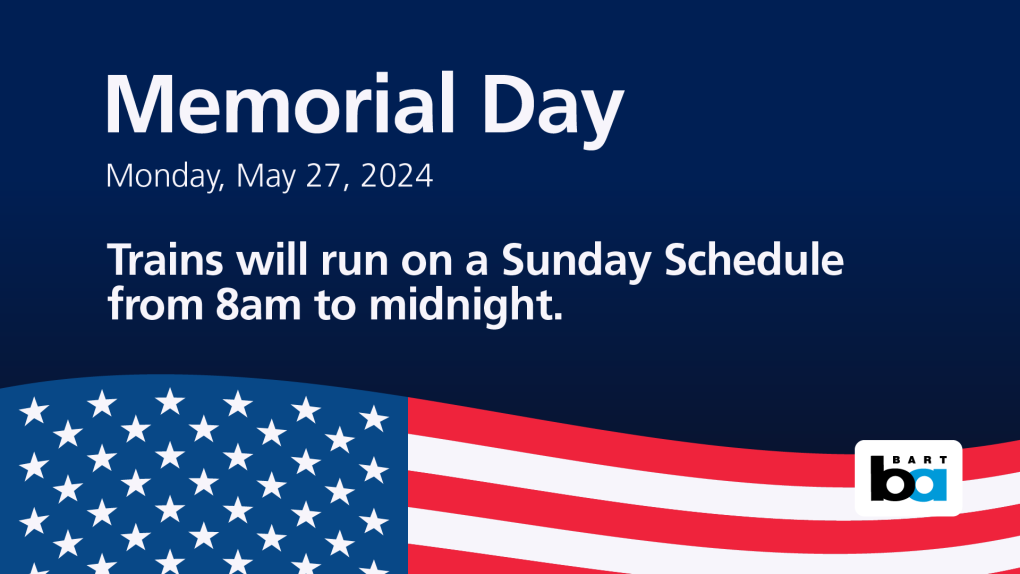Search Results
Installation work to begin February 21 for Next Generation Fare Gates at Lafayette Station
The installation of Next Generation Fare Gates is scheduled to begin February 21 at Lafayette Station. The installation process is expected to take approximately two weeks to complete for each of the station’s two sets of gates.
The opposite set of gates will remain in service during the installation. The work will not impact train service, but riders may experience a few extra minutes wait to pass through the fare gates during peak travel hours.
The latest work comes after BART has successfully installed Next Generation Fare Gates at 18 other stations across the system. All 50 BART stations will have new fare gates by the end of 2025. You can learn more about BART’s Next Generation Fare Gate project here.
Lake Merritt parking lot to permanently close 9/16/24 as TOD construction begins
Starting September 16, 2024, our exciting project to develop the land around Lake Merritt Station to include affordable and market-rate housing, offices, and retail space will officially begin. To accommodate this Transit-Oriented Development (TOD) project, the parking lot will be permanently closed starting September 16, 2024.
The lot is available for Daily Fee parking on a first-come, first-served basis until September 15. Daily Fee parking payment is required Monday-Friday, 4am-3pm, except on BART holidays. Pay for Daily Fee parking with the BART Official App or remember your stall number and pay inside the station via cash, credit, or debit.
Reserved parking is available at Fruitvale Station, MacArthur Station and many other BART locations with parking.
This article was originally posted on August 14, 2024
Fremont Station: Accessibility improvements- 2023/2024
UPDATE March 4. 2024
There will be a short construction phase at Fremont that will affect bus locations for two AC Transit lines from Monday 3/4 to Wednesday 3/6.
During this time, the following bus lines only will move:
- AC Transit line 251 will be in bay C2
- AC Transit line 212 will be in bay C3
All employer shuttles will be in bays C4 and C5. On 3/7, they will return to their regular locations:
- Line 251 will return to bay B4
- Line 212 will return to bay B5
UPDATE December 29, 2023
The next phase of work at Fremont will start on January 15th and will last 2-3 weeks. Buses will move locations on January 19th. During construction, all pedestrian detours will be accessible (see map below).
On the West side of the station:
- The central portion of the passenger loading zone on the station side of the roadway will be closed for construction and pedestrian detours around the construction.
- Accessible loading will be located on the side farther from the station entrance.
- A temporary crosswalk will be installed on the south side of the loading zone providing an accessible path to the temporary accessible loading and parking.
- A portion of accessible parking south of the station will also be closed for construction.
- A temporary accessible parking area is be installed in the small parking area next to the passenger loading area. This will remain for all phases of construction.
On the East side of the station:
- The passenger loading zone will be closed for construction. Passenger loading will take place just north of this.
- An accessible pedestrian detour will be provided at the location of the stairs to the lower plaza and station entrance.
- There will be no construction in the bus area during this phase. Buses will return to their normal locations. Please check signs and/or the list below for the location of your bus.
AC Transit/Stanford Marguerite Buses:
- Line 99: B2 (B1 overflow)
- Line 200: A3 (A2 overflow)
- Line 212: B5
- Line 215: A1
- Line 216 (Union City BART): A5
- Line 216 (Silliman Recreation Center): A6
- Line 217: A4
- Line 232: A8
- Line 239: A7
- Line 251: B4
- Line 707: A4
- Line 801: A3
- Line U and Stanford Marguerite Lines AE-F, EB: C1
Employer shuttles: C5

UPDATE December 11, 2023:
The next phase of work at Fremont will start on December 12th and will last approximately 3 weeks.
During construction, all pedestrian detours will be accessible.
On the West side of the station, taxis will return to their permanent location, and the north portion of the passenger loading zone and a section of accessible parking will be closed for construction. A temporary accessible parking area will be installed in the small parking area next to the passenger loading area. This will remain for all phases of construction.
On the East side of the station, construction will close bus bays A1, A2, B1, B3, and B4, and will require the relocation of most bus routes (see map below). Please check signs and/or the list below for the location of your bus.
AC Transit/Stanford Marguerite Buses:
- Line 99: C1
- Line 200: A3 (A4 overflow)
- Line 212: C4
- Line 215: B2
- Line 216 (Union City BART): A5
- Line 216 (Silliman Recreation Center): A6
- Line 217: A8
- Line 232: B6
- Line 239: A7
- Line 251: B5
- Line 707: A8
- Line 801: A3
- Line U and Stanford Marguerite Lines AE-F, EB: C3
Employer shuttles: C5
The Accessibility Improvement Program (AIP) will improve accessibility in and around BART stations to better meet the needs of people with disabilities, including replacement or upgrade of ramps, sidewalks and accessible paths, bus and passenger loading zones, as well as handrails, wall protrusion detection, wheelchair-accessible phones, TTY devices, courtesy phones, and elevator lobby lighting.
The work at Fremont Station will be done in phases with full completion by Spring 2024.
Thank you for your patience as we work to improve access to the BART Station.

UPDATE November 9, 2023:
The next phase of work at Fremont will start on November 13th and will last approximately 4 weeks.
During construction, all pedestrian detours will be accessible. On the West side of the station, taxis will be moved to the end of the loading zone on the right as you exit the station and the accessible loading zone will shift slightly. Some accessible parking will be closed, and a temporary accessible parking area will be installed in the small parking area next to the passenger loading area. This will remain for all phases of construction.
On the East side of the station, construction will close bus bays A3, A4, and will require the relocation of most bus routes. Please check signs and/or the list below for the location of your bus. AC Transit/Stanford Marguerite Buses will be relocated to the following bus bays:
- Line 99: B2 (no change)
- Line 200: A2
- Line 212: C4
- Line 215: B3
- Line 216 (Union City BART): A5
- Line 216 (Silliman Recreation Center): A6
- Line 217: A8
- Line 232: C3
- Line 239: A7
- Line 251: B4 (no change)
- Line 707: A8
- Line 801: A2
- Line U and Stanford Marguerite Lines AE-F, EB: C1 (no change)
Employer shuttles: C2, C5, B5 (Check with your shuttle operator)
The Accessibility Improvement Program (AIP) will improve accessibility in and around BART stations to better meet the needs of people with disabilities, including replacement or upgrade of ramps, sidewalks and accessible paths, bus and passenger loading zones, as well as handrails, wall protrusion detection, wheelchair-accessible phones, TTY devices, courtesy phones, and elevator lobby lighting.
The work at Fremont Station will be done in phases with full completion by Spring 2024.
Thank you for your patience as we work to improve access to the BART Station.

NOTE: The information below was originally posted on October 6, 2023
Construction for the first phase of the Fremont Station Accessibility Improvements Project will begin on Thursday, October 12, 2023 and last for approximately 5 weeks.
During this first phase, work will take place primarily on the west side of the station. Taxis will be moved to the end of the loading zone on the right as customers exit the station. The accessible loading zone will shift slightly. Some accessible parking will be closed and a temporary accessible parking area will be available in the small parking area next to the passenger loading area (see map). On the east side, sidewalk work will take place in the remote parking lots north of the station entrance.
All pedestrian detours will be accessible and temporary wayfinding signage will be posted to direct customers.
The Accessibility Improvement Program (AIP) will improve accessibility in and around BART stations to better meet the needs of people with disabilities, including replacement or upgrade of ramps, sidewalks and accessible paths, bus and passenger loading zones, as well as handrails, wall protrusion detection, wheelchair-accessible phones, TTY devices, courtesy phones, and elevator lobby lighting.
The work at Fremont Station will be done in phases with full completion by Spring 2024.
Thank you for your patience as we work to improve access to the BART Station.

Trains will run on Sunday schedule Memorial Day 5/27/24
On Monday, 5/27, Memorial Day, we will run a Sunday schedule for the holiday. This means BART will be operating from around 8am until around midnight. All five lines will be in service until around 9pm. After 9pm, BART will run three-line (Yellow, Blue and Orange) service.
For the most up-to-date schedule information use our Trip Planner or our official BART app to plan your specific trip.
Memorial Day is also a parking holiday. Parking will be free at all stations except for Milpitas and Berryessa/North San Jose stations; The Valley Transportation Authority operates the lots at Milpitas and Berryessa/North San Jose and their parking rates still apply. (Consult the VTA's site for more info on parking: Parking at the Milpitas & Berryessa Transit Centers | VTA.) All other parking rules will be enforced.

Acts Against State Law
Gender based violence and harassment is not tolerated at BART. While harassment of any kind is improper, California law does not specifically define general harassment as an illegal activity. While harassment is not tolerated within the BART system, a police officer would have to determine if the type of
Track shutdown scheduled for September 21 and 22 in Oakland postponed to October
The track shutdown that had been planned for Saturday, September 21 and Sunday, September 22 between Rockridge, MacArthur, and 19th Street stations has been postponed until October. The next shutdown weekend for the replacement of track switches in the core of the system in Oakland will be Saturday, October 19 and Sunday, October 20.
The postponement will allow BART to further evaluate lessons learned from the first shutdown weekend, which occurred in June. BART’s goal remains to minimize short term impacts on riders by maximizing work efficiency. Temporary shutdowns create a safe workspace for track crews while providing a massive boost in productivity thanks to uninterrupted 24/7 work. It’s still anticipated the rebuilding work will happen on 18 non-consecutive weekends over the next three years.
This project will benefit riders for decades to come by improving the reliability of the core of BART. The work is part of the Measure RR rebuilding program, which is revitalizing the system’s core infrastructure. Learn more about the project here.
Track shutdowns scheduled for October and November in Oakland postponed to 2025
The track shutdowns that had been planned for two weekends in October and November between Rockridge, MacArthur, and 19th Street stations have been postponed until next year.
The postponement will allow BART to focus on other priorities to improve reliability and limit future disruptions. We also continue to evaluate lessons learned from the first shutdown weekend in June, as we plan to adjust our approach and execution. BART’s goal remains to minimize short term impacts on riders by maximizing work efficiency. Temporary shutdowns create a safe workspace for track crews while providing a massive boost in productivity thanks to uninterrupted 24/7 work. This project will benefit riders for decades to come by improving the reliability of the core of BART.
It’s still anticipated the rebuilding work will happen on 18 non-consecutive weekends over the next three years starting in 2025. This work is part of the Measure RR rebuilding program, which is revitalizing the system’s core infrastructure.
Installation work to begin September 20th for Next Generation Fare Gates at Antioch Station
Installation of Next Generation Fare Gates is scheduled to begin September 20th at Antioch Station. The installation process is expected to take up to two weeks to complete. This work comes after the successful installation of Next Generation Fare Gates at Civic Center, Fruitvale, Richmond, and West Oakland stations.
During construction, there will be a barrier around the existing station gate array. Riders will use two temporary accessible gates to enter and exit Antioch Station. Both gates will be placed in front of the Station Agent Booth and will route riders through the existing service gate. Additionally, carpet will be installed immediately before the entrance to each fare gate, to make these two gates easier to locate for riders with visual impairments. The removal of the old gates and installation of the prototypes will not impact train service.
All BART stations will have new fare gates by the end of 2025. You can learn more about BART’s Next Generation Fare Gate project here. Riders can provide feedback about the new gates at bart.gov/comments.
Fare Gate replacement work to begin July 18 at Civic Center Station
On Thursday, July 18, BART will begin replacing the existing fare gates on the concourse level of Civic Center Station with new Next Generation Fare Gates.
The work at Civic Center will happen at the array, or set of gates, closest to Seventh Street entrance on the north end of the concourse level of the station (Array 1 in the map). A temporary barrier will be installed to provide a safe workspace for the installation team as well as to protect riders from construction. Installing this new array is expected to take several weeks to complete. The station’s other two fare gate arrays (Array 2 and Array3) will remain open during the installation work.
Once the new array is installed, BART will move forward with replacing all remaining old fare gates at Civic Center Station, one array at a time. In April, crews successfully installed a new fare gate at the elevator entrance on the Civic Center Station platform.
Get more details on Next Generation Fare Gates at our project page. Riders can provide feedback about the new gates at bart.gov/comments.